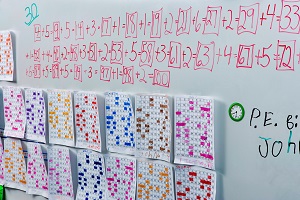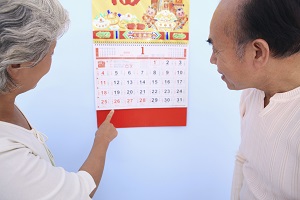Xuan Kong Da Gua (玄空大卦) is a metaphysical system meant for selecting auspicious days to conduct certain activities and to avoid bad days as well.
It makes fundamental use of the 64 hexagrams which are made up of two trigrams stacked together. For this reason it is also sometimes simply referred to as the 64 hexagrams method.
A date selection expert would require at least an intermediate level of proficiency in various other metaphysical concepts to properly put the concept of Xuan Kong Da Gua (XKDG) into practice.
Some of these disciplines include:
- YiJing
- WuXing
- Hsia calendar
- GanZhi
- Bazi
- JiaZi
- etc
Because of the complexity and sheer amount of data that can be generated from a fully comprehensive XKDG analysis, the application of this method of date selection is sometimes known as reverse date selection. This is due to it being used to analyze selected dates instead of selecting dates in the first place.
For example, a couple might have a shortlist of 3 dates for marriage from consulting the Chinese Almanac. And XKDG is used to determine which day (and hour) is the best one, not to come up with the original date options. Because if we are to get concise, there are 12 charts alone for each day to assess. 84 in a week and 360 for a whole month of 30 days. This is why dating practitioners always ask for specific dates to evaluate.
It is not that XKDG cannot be used to find the most auspicious dates for an event to take place. It’s just that using this approach demands extensive effort on the part of the reader, especially when there are little perimeters set by the asker.

Yet the attraction of XKDG is often due to the details involved in the technique. So much so that moving into a new home or groundbreaking for example, would account for the natal data of the property itself to find a good date.
This is a key reason why it is the preferred method of date selection for some people against something that is more generic like the Tong Shu.
The workings of Xuan Kong Da Gua
Xuan Kong Da Gua uses the concept of 8 periods unlike flying stars feng shui which uses 9. This is even though they belong under the same San Yuan umbrella. However the 8 periods theory is similar to that of 6 laws.
In essence, XKDG charts the energy dynamics between a property and it’s residents, with the Chi of heaven and earth. So in a way, it can be said that in layman terms, XKDK is a systemic study of the link connecting man with heaven and earth.
A dominant factor of XKDG analysis is the identification and usage of the element of a time or subject.
This is determined by the day pillar generated.
For example, the 4 pillars of 6 January 2021 at 4pm would have the day pillar of 甲寅 (jiayin). New learners of Chinese metaphysics might assume that from this pillar, the element involved would be Wood as that is the element represented by the heavenly stem and earthly branch. But this is not how it works in XKDG.
The element in this case would depend on the upper trigram in the 甲寅 hexagram. When this is identified, a number is assigned to it according to it’s position on the Hetu bagua and number at the same position in the Luoshu grids. The number is then referenced back to the Hetu rivermap to identify the element. In practice, only the number is used, which is called the element number (玄空五行).
The logic behind this is in part due to XKDG not recognizing the ability of stars to fly from one palace to another. Instead they lean on the palaces, implying that the 5 yellow for example never leaves the central palace.
So while Xuan Kong Fei Xing (flying stars) and Xuan Kong Da Gua (great hexagram) both falls under the greater umbrella of San Yuan, they are markedly different as if coming to a T-junction with one moving left and the other turning right.
However, this does not mean that this system is static. Changing yao lines (爻神) in advanced applications takes XKDG to a different level. Consider that there are 384 yao lines on a 360° compass. Indicating that each line is lesser than 1°. This indicates that a 1° change in a house’s sitting-facing can potentially turn it’s natal energy structure on it’s head.
From the previous example, a 甲寅 pillar would have the element number of 7 and associated with the fire element. A table that indicates all JiaZi pillars and their XKDG elements can be found here.
With each pillar also comes a period number (挨星卦運). This is calculated by tabulating the difference of the yao lines that make up the lower and upper trigrams. A table indicating all the period numbers associated with each pillar is illustrated here.
In practice, the element number is usually set above the pillar and the period number below. A bazi chart generated for XKDG resembles the below.
| 7 | 4 | 9 | 2 |
| 己 Ji (H6) – Earth |
丙 Bing (H3) + Fire |
庚 Geng (H7) + Metal |
庚 Geng (H7) + Metal |
| 卯 Mao (E4) – Wood |
辰 Chen (E5) + Earth |
戌 Xu (E11) + Earth |
子 Zi (E1) + Water |
| 7 | 1 | 9 | 9 |
The top row indicate the element number and the bottom row shows the period number.
The above example of a XKDG bazi chart (or natal chart) can be assigned to each date and time, person, or even a building. Date selection would then analyze and interpret how the interaction of these charts mean an auspicious or inauspicious day.
The auspiciousness of a selected date would heavily depend on one of (if not many) of the below criteria.
- Same element number
- Sum of 10
- Hetu combination
- Elemental growth relationship
- Elemental control relationship
- Seasonal combination
- 3 harmony combination
- etc
For example if a date to move into a property has the a day pillar that gives it the number 2, it is of fire element. If the building has the number 7, it would also be of fire element. In this case, it is a 2-7 hetu combination which represents auspiciousness.
In another example, let’s take a person with the element number 4 and a date with element number 7. As the center of focus is the individual, it can be observed that 7 controls 4 in their elemental relationship. In this case, it would be a good date.
Refinement of date selection would then include the application of the 5 yellow, 3 killings and the grand duke to avoid celestial afflictions.
In general, same kua is appropriate for activities that are short term. Hetu combinations are good for business activities and children-related matters. Sum of 10 is good for health, moving into new home, shifting of furniture, and relationships.
As there are many diverse variables at play, one must note that it is not often possible to find a date that meets all the auspicious criteria. And even if you are lucky enough to find such a date, real world circumstances can render that particular date unusable.
In such instances, priority of criteria should be given to any of same kua, sum of 10, hetu numbers. Followed by growth and control relationships. And avoidance of clashes and celestial afflictions.
Xuan Kong Da Gua is by no means an entry level method of Chinese date selection. The various components at play and the avalanche of data involved mean that basic learners would not be able to fully comprehend the working dynamics that make the system work.
However, for those with an intermediate understanding of the fundamentals in Chinese metaphysics, the basics is a simple date selection concept to pick up.















